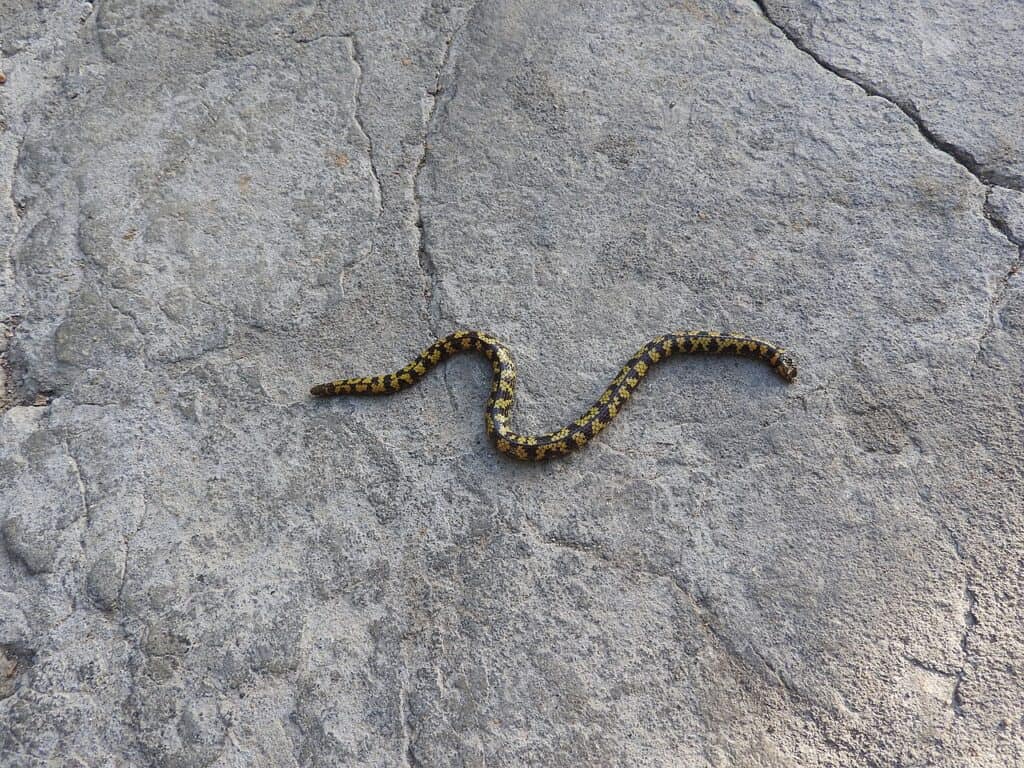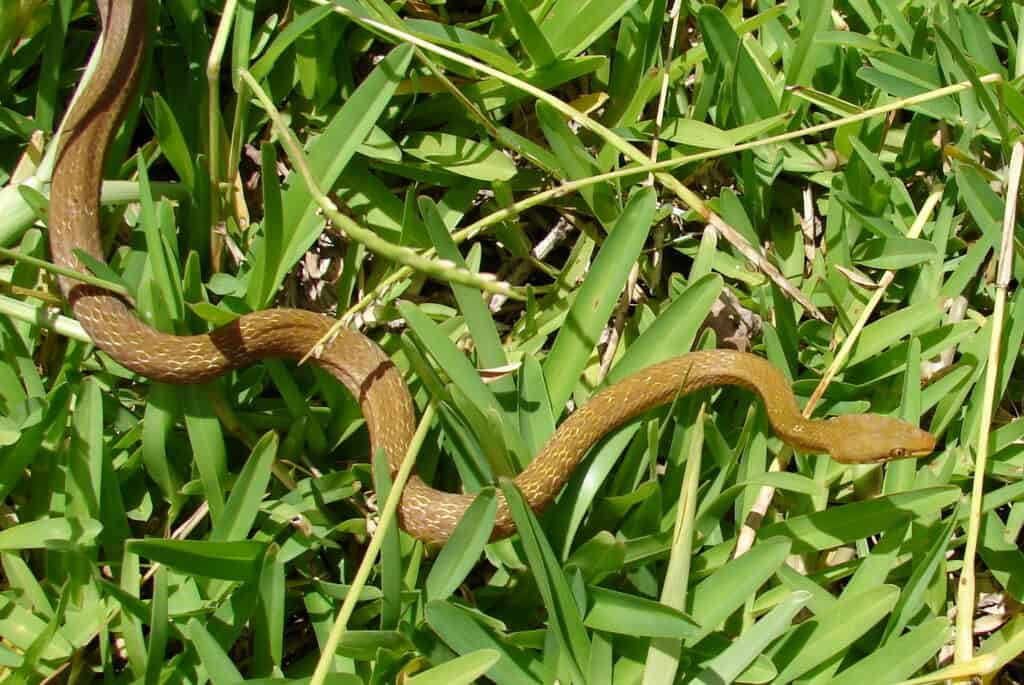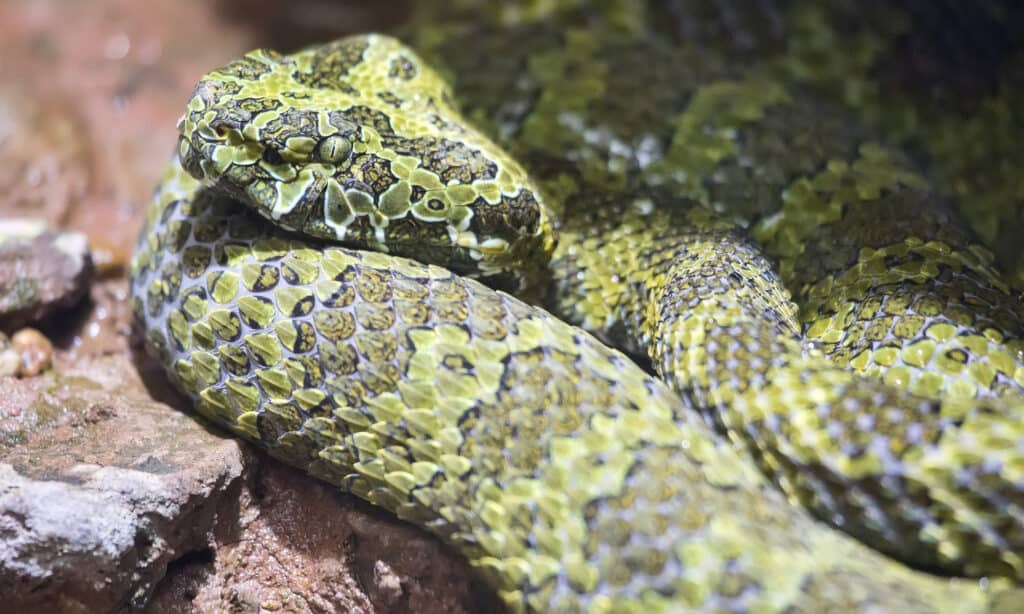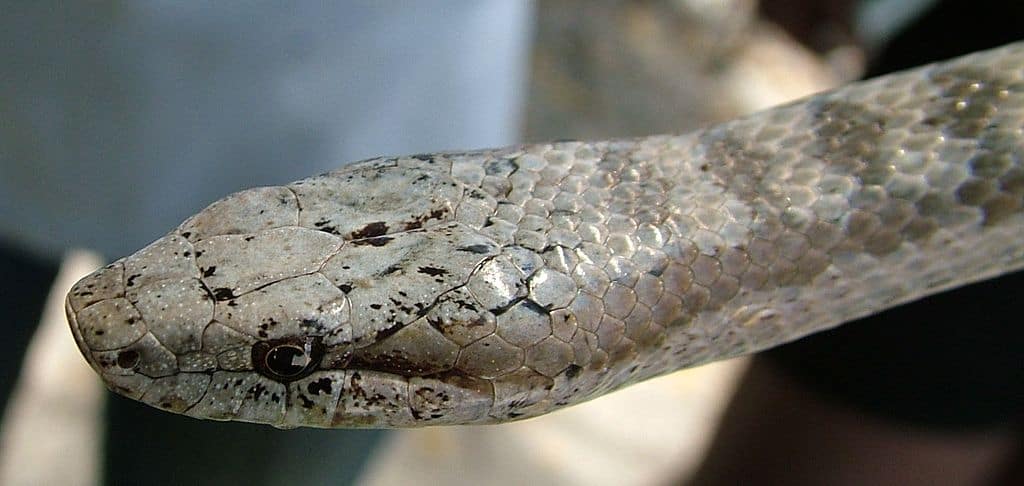Globally, more than 40,000 species currently face extinction. Causes of extinction include habitat loss, habitat fragmentation, poaching, and climate change. All around the world, there are hundreds of species of endangered snakes we should act to save. Many of these snakes only occur in tiny, restricted habitats, making them vulnerable to extinction.
Here, we’ll take a closer look at ten species of endangered snakes and what their greatest threats are.
10. Shevaroy Hills Earth Snake (Uropeltis shorttii)

Shevaroy Hills earth snakes are also known as Shortt’s shieldtail snakes.
©Yercaud-elango / Creative Commons – License
Shevaroy Hills Earth snakes live only in the southern part of the Eastern Ghats in India. They’re non-venomous and completely harmless to humans. Shevaroy snakes burrow in the ground and eat worms. Based on the small amount of information available, their population is thought to be extremely fragile and in danger of extinction.
9. Seychelles Wolf Snake (Lycognathophis seychellensis)

Seychelles
wolf snakes
display an olive-brown color.
©Dao Nguyen and James Hardcastle / Creative Commons – License
Seychelles wolf snakes are one of Earth’s endangered snakes we should act to save. They live only in the forests of the Republic of Seychelles, an island country off the coast of East Africa. They grow to about three feet long and display an olive-brown color. The Seychelles wolf snake’s primary threat comes from habitat loss.
8. Ashe’s Bush Viper (Atheris desaixi)

The Ashe’s bush viper is also known as the Mount Kenya bush viper or Desaix’s bush viper
©United States Army Center for Health Promotion and Preventive Medicine / Public Domain – License
Ashe’s bush vipers live in only two areas of Kenya and nowhere else in the world. Like the spiny bush viper, they’re spiny and have yellow and black scales in undulating patterns. Ashe’s bush vipers are small, growing to only two feet long as adults. They spend their lives in the trees, hunting for small mammals, reptiles, and birds.
7. Mangshan Pit Viper (Protobothrops mangshanensis)

The Mangshan pit viper is also known as the Mt. Mang pit viper or the Mang Mountain pit viper.
©Bill Kennedy/Shutterstock.com
Mangshan pit vipers are one of the brightest-colored endangered snakes we should act to save. These snakes live in the Hunan and Guangdong provinces of China, where they hunt for reptiles, amphibians, birds, insects, and small mammals. Mangshan vipers exhibit striking lime-green and olive-green markings and have a flat, triangular head. As vipers, they are venomous, and bites can kill people if left untreated.
6. Antiguan Racer (Alsophis antigua)

There isn’t much information regarding the Antiguan racer’s behavior; it’s one of Earth’s rarest snakes.
©Wallamalloo69 at English Wikipedia / Public domain, Wikimedia Commons – License
Antiguan racers live only on the islands of Antigua. Adults grow to just over three feet long and range in color from black to brown to almost white. Though little is known about these endangered snakes, they have been observed both in forested areas and beach environs. Unlike other snakes who eat a mixed diet, Antiguan racers eat mostly lizards. Their biggest threats are habitat loss and poaching. Along with number one on our list, they’re frequently listed as one of the most endangered snakes on Earth.
5. March’s Palm Pit Viper (Bothriechis marchi)

March’s palm pit vipers live in the Central American countries of Honduras and Guatemala.
©Animantium Productions/Shutterstock.com
The March’s palm pit viper is number five on our list of endangered snakes we should act to save. These venomous, tree-dwelling snakes live in the forests of Central America. Scientists estimate that their population is in severe decline. March’s palm pit vipers grow to around three feet long and have slim bodies with green scales. Their primary threats come from habitat loss, habitat fragmentation, and poaching.
4. Venezuela Forest Pit Viper (Bothrops medusa)
In the same family as March’s palm pit vipers, Venezuela forest pit vipers also face extinction. These snakes live in Venezuela, where they hunt small mammals, reptiles, amphibians, and even birds. As pit vipers, they have heat-sensing pits and highly toxic venom. Their coloring ranges from tan to light brown, with patterned stripes ringing the body. They have a maximum length of about 2.5 feet. Their primary threats are habitat loss and poaching.
3. Peters’ Bright Snake (Liophidium mayottensis)
Peters’ bright snakes may not look like much, but their small population size means that they’re easily one of the endangered snakes we should act to save. These snakes live only on a single island off the coast of Africa. They look like nothing so much as long, thin, brown worms. They’re harmless and come out only at night. But, like so many other rare snake species, they’re in danger of extinction due to habitat loss, habitat fragmentation, climate change, and poaching by humans.
2. Pfeffer’s Reed Snake (Calamaria pfefferi)
Pfeffer’s reed snakes live in the Ryukyu Islands of Japan. They’re extremely rare and found in only isolated populations. Pfeffer’s reed snakes are dark brown to black and have long slender bodies. They resemble legless lizards and can have vibrant mahogany and black scales. Their heads are no thicker than their necks. Pfeffer’s reed snakes live in wooded areas and grasslands. They are currently in danger of extinction due to habitat loss, though little is known about their actual population size.
1. Ornate Ground Snake (Erythrolamprus ornatus)
Ornate ground snakes are one of the world’s rarest snakes. They’re also known as Saint Lucia racers; they live only on the island of Maria Major in Saint Lucia. Researchers estimate that there are fewer than 20 surviving ornate ground snakes on the island. Once, Saint Lucia racers populated the whole of Saint Lucia. But, thanks to the predation of invasive species, like mongooses, they now live only on the outlying island of Maria Major. Ornate ground snakes are non-venomous and grow no longer than four feet long.
Summary of 10 Endangered Snakes We Should Act to Save
| # | Endangered Snake | Location |
|---|---|---|
| 1 | Ornate Ground Snake | Island of Maria Major in Saint Lucia |
| 2 | Pfeffer’s Reed Snake | Ryukyu Islands of Japan |
| 3 | Peters’ Bright Snake | Small island off the coast of Africa |
| 4 | Venezuela Forest Pit Viper | Venezuela |
| 5 | March’s Palm Pit Viper | Central America |
| 6 | Antiguan Racer | Antigua |
| 7 | Mangshan Pit Viper | China |
| 8 | Ashe’s Bush Viper | Kenya |
| 9 | Seychelles Wolf Snake | Republic of Seychelles |
| 10 | Shevaroy Hills Earth Snake | The Eastern Ghats in India |
The photo featured at the top of this post is © Opayaza12/Shutterstock.com
Discover the "Monster" Snake 5X Bigger than an Anaconda
Every day A-Z Animals sends out some of the most incredible facts in the world from our free newsletter. Want to discover the 10 most beautiful snakes in the world, a "snake island" where you're never more than 3 feet from danger, or a "monster" snake 5X larger than an anaconda? Then sign up right now and you'll start receiving our daily newsletter absolutely free.
Thank you for reading! Have some feedback for us? Contact the AZ Animals editorial team.






